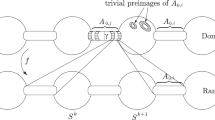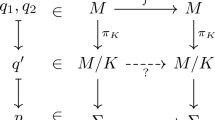Abstract
We consider Thurston maps: branched self-coverings of the sphere with ultimately periodic critical points, and prove that the Thurston equivalence problem between them (continuous deformation of maps along with their critical orbits) is decidable. More precisely, we consider the action of mapping class groups, by pre- and post-composition, on branched coverings, and encode them algebraically as mapping class bisets. We show how the mapping class biset of maps preserving a multicurve decomposes into mapping class bisets of smaller complexity, called small mapping class bisets. We phrase the decision problem of Thurston equivalence between branched self-coverings of the sphere in terms of the conjugacy and centralizer problems in a mapping class biset. Our decomposition results on mapping class bisets reduce these decision problems to small mapping class bisets; they correspond to rational maps, homeomorphisms and maps double covered by a torus endomorphism, and their conjugacy and centralizer problems are solvable respectively in terms of complex analysis, group theory and linear algebra. Branched coverings themselves are also encoded into bisets, with actions of the fundamental groups. We characterize those bisets that arise from branched coverings between topological spheres, and extend this correspondence to maps between spheres with multicurves, whose algebraic counterparts are sphere trees of bisets. To illustrate the difference between Thurston maps and homeomorphisms, we produce a Thurston map with infinitely generated centralizer—while centralizers of homeomorphisms are always finitely generated.





Similar content being viewed by others
Notes
Available from www-polsys.lip6.fr/~jcf/FGb/.
References
Bartholdi, L., Nekrashevych, V.V.: Thurston equivalence of topological polynomials. Acta Math. 197(1), 1–51 (2006). https://doi.org/10.1007/s11511-006-0007-3. arXiv:math/0510082. https://www.gap-system.org
Bartholdi, L., Dudko, D.: Algorithmic aspects of branched coverings. Ann. Fac. Sci. Toulouse 5, 1219–1296 (2017). https://doi.org/10.5802/afst.1566. arXiv:1512.05948
Bartholdi, L., Dudko, D.: Algorithmic aspects of branched coverings I/V Van Kampen’s theorem for bisets. Groups Geom. Dyn. 12(1), 121–172 (2018). https://doi.org/10.4171/GGD/441. arXiv:1512.08539
Bartholdi, L., Dudko, D.: Algorithmic aspects of branched coverings IV/V. Expanding maps. Trans. Am. Math. Soc. 370(11), 7679–7714 (2018). https://doi.org/10.1090/tran/7199. arXiv:1610.02434
Bartholdi, L., Mitrofanov, I.: The word and order problems for self-similar and automata groups. Groups Geom. Dyn. 14(2), 705–728. https://doi.org/10.4171/GGD/560 (2020). arXiv:1710.10109
Bartholdi, L., Dudko, D.: Algorithmic aspects of branched coverings III/V. Erasing maps, orbispaces, and the Birman exact sequence (2018). arXiv:1802.03045 (submitted)
Bartholdi, L., Dudko, D.: Algorithmic Aspects of Branched Coverings V/V. Symbolic and Floating-Point Algorithms (2020). (in preparation)
Bartholdi, L., Buff, X.: Hurwitz Space and Its Compactification (2020). (in preparation)
Bell, M.C., Webb, Richard C.H.: Polynomial-Time Algorithms for the Curve Graph (2016) arXiv:1609.09392
Bestvina, M., Handel, M.: Train-tracks for surface homeomorphisms. Topology 34(1), 109–140 (1995). https://doi.org/10.1016/0040-9383(94)E0009-9
Birman, J.S., Series, C.: An algorithm for simple curves on surfaces. J. Lond. Math. Soc. (2) 29(2), 331–342 (1984). https://doi.org/10.1112/jlms/s2-29.2.331
Bonnot, S., Braverman, M., Yampolsky, M.: Thurston equivalence to a rational map is decidable. Mosc. Math. J. 12(4), 747–763, 884 (2012). https://doi.org/10.17323/1609-4514-2012-12-4-747-763 (English, with English and Russian summaries)
Brown, R.: Fibrations of groupoids. J. Algebra 15, 103–132 (1970). https://doi.org/10.1016/0021-8693(70)90089-X
Calvez, M.: Fast Nielsen–Thurston classification of braids. Algebr. Geom. Topol. 14(3), 1745–1758 (2014). https://doi.org/10.2140/agt.2014.14.1745
Cannon, J.W., Floyd, W.J., Parry, W.R., Pilgrim, K.M.: Nearly Euclidean Thurston maps. Conform. Geom. Dyn. 16, 209–255 (2012). https://doi.org/10.1090/S1088-4173-2012-00248-2
Cohen, M., Lustig, M., Paths of geodesics and geometric intersection numbers. I, Combinatorial Group Theory and Topology (Alta, Utah, 1984), Ann. of Math. Stud., vol. 111, Princeton University Press, Princeton, NJ, pp. 479–500 (1987)
Douady, A., Hubbard, J.H.: Étude dynamique des polynômes complexes. Partie I, Publications Mathématiques d’Orsay [Mathematical Publications of Orsay], vol. 84, Université de Paris-Sud, Département de Mathématiques, Orsay (1984) (French)
Douady, A., Hubbard, J. H.: Étude dynamique des polynômes complexes. Partie II, Publications Mathématiques d’Orsay [Mathematical Publications of Orsay], vol. 85, Université de Paris-Sud, Département de Mathématiques, Orsay (1985) (French). With the collaboration of P. Lavaurs, Tan Lei and P. Sentenac
Douady, A., Hubbard, J.H.: A proof of Thurston’s topological characterization of rational functions. Acta Math. 171(2), 263–297 (1993). https://doi.org/10.1007/BF02392534
Epstein, D.B.A.: Curves on 2-manifolds and isotopies. Acta Math. 115, 83–107 (1966). https://doi.org/10.1007/BF02392203
Farb, B., Margalit, D.: A Primer on Mapping Class Groups. Princeton Mathematical Series, vol. 49. Princeton University Press, Princeton, NJ (2012)
Floyd, W., Kelsey, G., Koch, S., Lodge, R., Parry, W., Pilgrim, K.M., Saenz, E.: Origami, affine maps, and complex dynamics. Arnold Math. J. 3(3), 365–395 (2017). https://doi.org/10.1007/s40598-017-0071-0
Floyd, W., Parry, W., Pilgrim, K.M.: Presentations of NET maps. Fund. Math. 244(1), 49–72 (2019). https://doi.org/10.4064/fm351-11-2017. arXiv:1701.00443
Floyd, W., Parry, W., Pilgrim, K.M.: Modular groups, Hurwitz classes and dynamic portraits of NET maps. Groups Geom. Dyn. 13(1), 47–88 (2019). https://doi.org/10.4171/GGD/479. arXiv:1703.03983
de la Harpe, P.: Topics in Geometric Group Theory. University of Chicago Press, Chicago, IL (2000)
Hemion, G.: On the classification of homeomorphisms of 2-manifolds and the classification of 3-manifolds. Acta Math. 142(1–2), 123–155 (1979). https://doi.org/10.1007/BF02395059
Hurwitz, A.: Ueber Riemann’sche Flachen mit gegebenen Verzweigungspunkten. Math. Ann. 39(1), 1–60 (1891). https://doi.org/10.1007/BF01199469. (German)
Kameyama, A.: The Thurston equivalence for postcritically finite branched coverings. Osaka J. Math. 38(3), 565–610 (2001). http://projecteuclid.org/euclid.ojm/1153492513
Koch, S.: Teichmuller theory and critically finite endomorphisms. Adv. Math. 248, 573–617 (2013). https://doi.org/10.1016/j.aim.2013.08.019
Koch, S.C., Pilgrim, K.M., Selinger, N.: Fullback invariants of Thurston maps. Trans. Am. Math. Soc. 368(7), 4621–4655 (2016). https://doi.org/10.1090/tran/6482. arXiv:1212.4568
Lando, S.K., Zvonkin, A.K.: Graphs on surfaces and their applications, Encyclopaedia of Mathematical Sciences, vol. 141, Springer, Berlin. With an appendix by Don B. Zagier; Low-Dimensional Topology, II (2004)
Lodge, R.: Boundary values of the Thurston pullback map. Conform. Geom. Dyn. 17, 77–118 (2013). https://doi.org/10.1090/S1088-4173-2013-00255-5
Magnus, W., Karrass, A., Solitar, D.: Combinatorial Group Theory: Presentations of Groups in Terms of Generators and Relators. Interscience, New York (1966)
Margalit, D., McCammond, J.: Geometric presentations for the pure braid group. J. Knot Theory Ramif. 18(1), 1–20 (2009). https://doi.org/10.1142/S0218216509006859
McMullen, C.T.: Complex Dynamics and Renormalization. Annals of Mathematics Studies, vol. 135. Princeton University Press, Princeton, NJ (1994)
Nekrashevych, V.V.: Self-similar Groups. Mathematical Surveys and Monographs, vol. 117. American Mathematical Society, Providence, RI (2005)
Nekrashevych, V.: Combinatorial models of expanding dynamical systems. Ergod. Theory Dyn. Syst. 34(3), 938–985 (2014). https://doi.org/10.1017/etds.2012.163
Nielsen, J.: Surface transformation classes of algebraically finite type. Danske Vid. Selsk. Math. Phys. Medd. 21(2), 89 (1944)
Parry, W.R.: NETmap (2018). http://www.math.vt.edu/netmaps
Pilgrim, K.M.: Combinations of Complex Dynamical Systems. Lecture Notes in Mathematics, vol. 1827. Springer, Berlin (2003)
Rips, E., Sela, Z.: Cyclic splittings of finitely presented groups and the canonical JSJ decomposition. Ann. Math. (2) 146(1), 53–109 (1997). https://doi.org/10.2307/2951832
Selinger, N.: Thurston’s pullback map on the augmented Teichmuller space and applications. Invent. Math. 189(1), 111–142 (2012). https://doi.org/10.1007/s00222-011-0362-3
Selinger, N.: Topological characterization of canonical Thurston obstructions. J. Mod. Dyn. 7(1), 99–117 (2013). https://doi.org/10.3934/jmd.2013.7.99
Selinger, N., Yampolsky, M.: Constructive geometrization of Thurston maps and decidability of Thurston equivalence. Arnold Math. J. 1(4), 361–402 (2015). https://doi.org/10.1007/s40598-015-0024-4. arXiv:1310.1492
Serre, J.-P.: Trees, Springer, Berlin (1980). Translated from the French by John Stillwell
The GAP Group: GAP—Groups, Algorithms, and Programming, Version 4.4.10 (2008). https://www.gap-system.org
Thurston, W.P.: On the geometry and dynamics of diffeomorphisms of surfaces. Bull. Am. Math. Soc. (N.S.) 19(2), 417–431 (1988). https://doi.org/10.1090/S0273-0979-1988-15685-6
van Kampen, R.E.: On the connection between the fundamental groups of some related spaces. Am. J. Math. 55, 261–267 (1933). (English)
Zieschang, H., Vogt, E., Coldewey, H.-D.: Surfaces and Planar Discontinuous Groups, Lecture Notes in Mathematics, vol. 835. Springer, Berlin (1980). Translated from the German by John Stillwell
Acknowledgements
We are grateful to Ralf Meyer for enlightening discussions on fibrations of groupoids, and to Jean–Pierre Spaenlehauer for help in computing the equation of the algebraic correspondence in Sect. 9.2.2.
Author information
Authors and Affiliations
Corresponding author
Additional information
Publisher's Note
Springer Nature remains neutral with regard to jurisdictional claims in published maps and institutional affiliations.
Partially supported by ANR Grant ANR-14-ACHN-0018-01 and DFG Grant BA4197/6-1.
Rights and permissions
About this article
Cite this article
Bartholdi, L., Dudko, D. Algorithmic aspects of branched coverings II/V: sphere bisets and decidability of Thurston equivalence. Invent. math. 223, 895–994 (2021). https://doi.org/10.1007/s00222-020-00995-2
Received:
Accepted:
Published:
Issue Date:
DOI: https://doi.org/10.1007/s00222-020-00995-2




